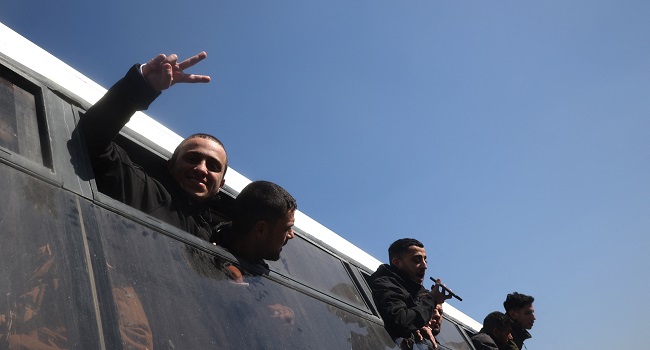
Palestinian militants released three Israeli hostages on Saturday, February 15 in exchange for hundreds of Palestinian prisoners released by Israel, and the latest exchange was completed despite growing concerns about the collapse of the Gaza truce agreement.
A reporter from AFP witnessed masked Hamas gunmen parading hostages on stage in the southern Gaza city of Khan Yunis, where they were sent into a microphone and then handed over to the Red Cross and transported back to Israeli territory . The three men held gift bags and certificates from the kidnappers and urged a further hostage exchange to be completed under the Ceasefire Agreement.
Not long after, a bus with Palestinian prisoners left Israel’s Ofer Prison and cheered in the occupied West Bank city of Ramallah. Other buses transport prisoners from Israeli prisons in the Negav Desert to the Gaza Strip.
Saturday’s exchange marks the sixth exchange since the truce came into effect on January 19. Hamas then threatened to stop warnings about alleged Israeli violations and Israeli actions to resume military operations if the deal collapsed.
Since the attack on Israel on October 7, 2023, the hostages released – Israeli-American Saji Dekel Chin, Israel – Russia’s Sasha Trapanov and Israel’s Argentina Yair Horn have been captured. Their family responded with relief and joy.
“In the end, Sasha can be surrounded by his loved ones and start a new path,” Trapanov’s family said in a statement. “My breath is back. He looks handsome.
Later, hundreds of Palestinians released by Israel arrived at Khan Yuni and waved to a cheerful crowd. According to the Palestinian Prisoners Club, Israel released 333 Gaza people and 36 prisoners during the war, 24 of whom were deported due to the armistice clause. Israel confirmed a total of 369 releases.
Images on Israeli media show Palestinian prisoners wearing sweatshirts with prison service logos, David’s star and slogan: “We won’t forget, we won’t forgive.”
A Hamas official said on Friday, February 14 that discussions are expected in the second phase of the ceasefire and are expected to begin early next week. Negotiations aim to establish steps towards a more permanent end to the war.
U.S. Secretary of State Marco Rubio’s country, the top ally of Israel and the main mediator, will arrive in Israel on Saturday, February 15 to meet Prime Minister Benjamin Netanyahu negotiation.
The Israeli campaign group hostages and missing families forum warned against allowing the ceasefire to collapse, urging negotiators to “continue to use this momentum to reach a swift and responsible deal for all”.
In Tel Aviv, a group of people gathered to watch the live feed of the exchange, waved the Israeli flag, and held the sign with messages like “Sorry and Welcome Back” and “Complete the Ceasefire.”
The situation of Israeli hostages and Palestinian prisoners has attracted attention. According to Red Crescent, the public display of the hostage’s decay last week caused anger, and several Palestinians released from Israel’s custody were hospitalized, with four more people transferred to a hospital in the West Bank on Saturday, February 15.
The ceasefire is under pressure after a controversial proposal by U.S. President Donald Trump to relocate Gaza’s population to Egypt or Jordan (Egypt or Jordan). Arab countries strongly rejected the plan, with Saudi Arabia scheduled to hold a summit on Thursday, February 13, with leaders from Egypt, Jordan, Qatar and the United Arab Emirates.
The joint statement of Christian leaders in Jerusalem also insists that Gaza people are “not allowed to be forced to exile.”
According to official Israeli figures, Hamas’s October 7 attack killed 1,211 people, mainly civilians. The militants also took 251 hostages, 70 of whom remained in Gaza, and 35 of which the Israeli military said were dead.
After Saturday’s release, Netanyahu’s office said it was working with the United States to get the freedom of the remaining hostages “as soon as possible”, although no other details were provided.
To date, Israel’s retaliatory military campaign has killed at least 48,264 people, most of them civilians.
